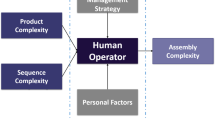Abstract
The increasing variety of products complicates the mixed-model assembly process and affected the mixed-model assembly system in terms of product quality and productivity. Choice complexity comes from the process of making choices for various assembly operations due to the product variety and impacts production rate which is the performance measure of the system. The choice complexity is measured with information entropy, and the relational expression between choice complexity and error rate is analyzed by means of those research finds on average reaction time and speed-accuracy trade-off. The main achievement of our study is establishing an artificial neural network meta-model for the impact of choice complexity on production rate. The meta-model performs better than a multiple linear regression meta-model in terms of experiment results and appears to be the optimal model of the impact of choice complexity on production rate in the mixed-model assembly system.
Similar content being viewed by others
References
Fisher ML, Jain A, Macduffie JP (1995) In: Bowman EH, Kogut BM (eds) Strategies for product variety: lessons from the auto industry. Redesigning the Firm, Chap. 6. Oxford University Press, New York
Fisher ML, Ittner CD (1999) The impact of product variety on automobile assembly operations: empirical evidence and simulation. Manag Sci 45(6):771–786
Niimi A, Matsudaira Y (1997) Development of a vehicle assembly line at Toyota: worker-orientated, autonomous, new assembly system. In: Shimokawa K, Jurgens U, Fujimoto T (eds) Transforming automobile assembly: experience in automation and work organization. Springer, Berlin
Benders J, Morita M (2004) Changes in Toyota motors’ operations management. Int J Prod Res 42(3):433–444
MacDuffie JP, Sethuraman K, Fisher ML (1996) Product variety and manufacturing performance: evidence from the international automotive assembly plant study. Manag Sci 42(3):350–369
Fujimoto H, Ahmed A, Iida Y, Hanai M (2003) Assembly process design for managing manufacturing complexities because of product varieties. Int J Flex Manuf Syst 15(4):283–307
Deshmukh AV, Talavage JJ, Barash MM (1998) Complexity in manufacturing systems, part 1: analysis of static complexity. IIE Trans 30(7):645–655
Araz OU, Eski O, Araz C (2008) Determining the parameters of dual-card kanban system: an integrated multicriteria and artificial neural network methodology. Int J Adv Manuf Technol 38:965–977
Anvari M, Mehrabad MS, Azadeh A, Saberi M (2010) Performance assessment of decision-making units using an adaptive neural network algorithm: one period case. Int J Adv Manuf Technol 46:1059–1069
Azadeh A, Moghaddam M, Geranmayeh P, Naghavi A (2010) A flexible artificial neural network–fuzzy simulation algorithm for scheduling a flow shop with multiple processors. Int J Adv Manuf Technol 50:699–715
Tseng MM, Jiao J (1996) Design for mass customization. CIRP Ann 45(1):153–156
Shannon CE (1948) A mathematical theory of communication. Bell Syst Tech J 27:379–423
Cheldelin B, Ishii K (2004) Mixed model assembly quality: an approach to prevent human errors. In: 2004 ASME International Mechanical Engineering Congress and Exposition (IMECE), Anaheim, CA, November 13–19, vol. 117. American Society of Mechanical Engineers, New York, NY, pp 109–19
Hick WE (1952) On the rate of gain of information. J Exp Psychol 4:11–26
Hyman R (1953) Stimulus information as a determinant of reaction time. J Exp Psychol 45:188–196
Wickelgren WA (1977) Speed-accuracy tradeoff and information processing dynamics. Acta Psychol 41:67–85
Zhang H, Jiang Z, Guo C (2009) Simulation-based optimization of dispatching rules for semiconductor wafer fabrication system scheduling by the response surface methodology. Int J Adv Manuf Technol 41:110–121
Huanmin Xu, Li D (2006) A meta-modeling paradigm of the manufacturing resources using mathematical logic for process planning. Int J Adv Manuf Technol 36:1022–1031
Sabuncuoglu I, Touhami S (2002) Simulation metamodeling with neural networks: an experimental investigation. Int J Prod Res 40:2483–2505
Chen MC, Yang T (2002) Design of manufacturing systems by a hybrid approach with neural network metamodeling and stochastic local search. Int J Prod Res 40:71–92
Kearns M (1996) A bound on the error of cross validation using the approximation and estimation rates, with consequences for the training-test split. Advances in Neural Information Processing Systems, vol. 8. MIT Press, Cambridge, pp 183–189
Lee SS, Chen JC (2003) On-line surface roughness recognition system using artificial neural networks system in turning operations. Int J Adv Manuf Technol 22:498–509
Moody JE, Rögnvaldsson T (1997) Smoothing regularizers for projective basis function networks. Adv Neural Inform Process Syst 9:585–591
Kleijnen J (1979) Regression metamodels for generalizing simulation results. IEEE Trans Sys Man Cybernet 9:93–96
Author information
Authors and Affiliations
Corresponding author
Rights and permissions
About this article
Cite this article
Wang, K., Rao, Y. & Wang, M. Modeling impact of choice complexity on production rate in mixed-model assembly system. Int J Adv Manuf Technol 59, 1181–1189 (2012). https://doi.org/10.1007/s00170-011-3530-0
Received:
Accepted:
Published:
Issue Date:
DOI: https://doi.org/10.1007/s00170-011-3530-0




